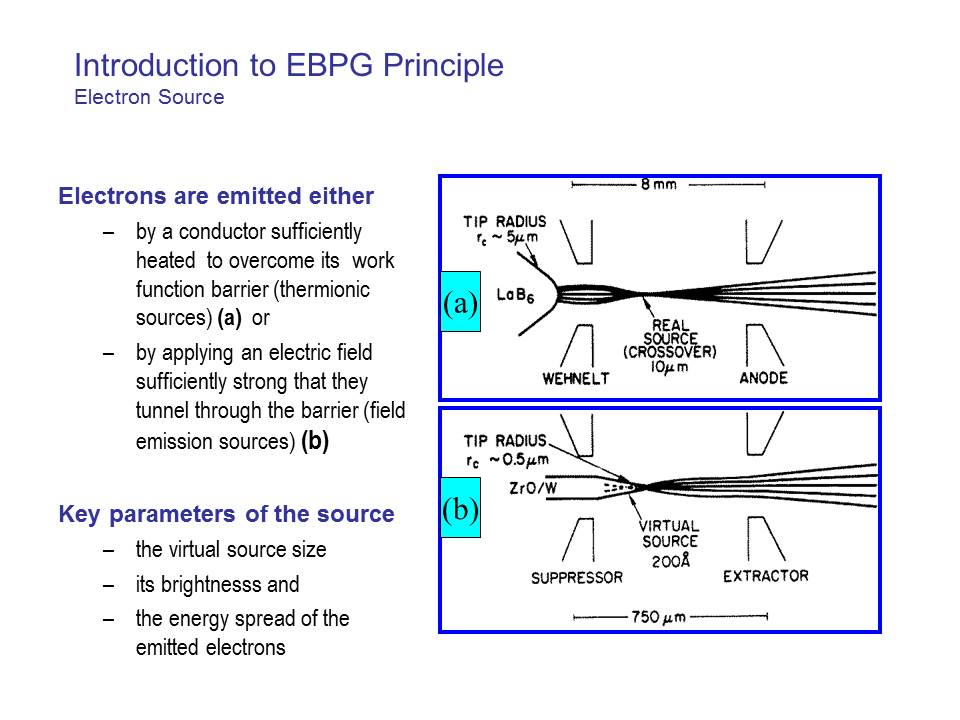EBPG hardware tour
EBPG hardware tour Page 1
Our EBPG uses the emitter shown in (b), and these days so does every other e-beam system. This electron source is called a “field emitter” because a high field at the tip induces electrons to tunnel out of the metal. It is called a “thermal field emitter” because the tungsten pin is kept hot to keep it clean. Also, the heater allows ZrO to flow down to the sharp end, where it lowers the work function of the metal.
EBPG hardware tour Page 2
There are three major lenses. The topmost is an electrostatic lens on the electron gun. The second is a magnetic lens which forms a crossover of the beam inside the blanker. The blanker uses an electric field to turn the beam on and off, and because it sits at a beam crossover, there is no image shift when the beam is blanked. The third lens focuses the beam to a spot on the substrate.
EBPG hardware tour Page 3
The stage is controlled with a laser interferometer, which is so accurate that it is used to calibrate beam deflection and distortion. You might think that it works by counting fringes, but no. It actually works just like the State Trooper’s radar gun, measuring a Doppler shift as the stage moves. By integrating the speed of the stage, this interferometer can measure the stage position to less than a nanometer. (It’s really quite interesting how the laser works. The He-Ne laser contains a magnet which splits the optical line with the Zeeman effect. The split frequencies are detected with a mixer that generates a difference signal in the gigahertz range. This is a low enough frequency to be measured with common electronics which measure the frequency shift as the stage moves.)
EBPG hardware tour Page 4
EBPG hardware tour Page 5
Secondary electrons from the substrate are picked up with a set of four scintillators on light-pipes on photomultiplier tubes. These are just like the detectors in scanning electron microscopes, except that there is no bias drawing in the scattered electrons. A bias would distort the writing field. Unfortunately the lack of bias makes the detectors inefficient, and so the system does not make a good electron microscope. Of course, it operates at 100kV, so that would make a terrible SEM in any case! It might surprise you to find that things easily seen in a SEM can be nearly invisible in the EBPG. That’s why the choice of materials for alignment marks is so critical and restricted.
Other e-beam writing systems use silicon diodes as detectors. These are not as fast as photomultiplier tubes, but they are more efficient at collecting the signal.
EBPG hardware tour Page 6
Another laser in the system measures the sample height. The height is measured on each exposure field, after which the EBPG corrects the focus and field size. This measurement and correction takes just a few milliseconds. You might wonder how the height measurement is converted to a focus correction. Well I’m going to tell you anyway. Think of the plot of focus versus height-signal: it’s more or less a straight line, and the slope never changes. The y-intercept of that straight line is determined while calibrating the system before an exposure. During calibration, the EBPG automatically focuses on a reference mark, and then measures the height with the laser sensor. This sets the offset; that is, the y-intercept of focus versus height.
EBPG hardware tour Page 7
There are two sets of deflection magnets: the (slow) main field deflector and the (fast) trapezium deflector. The origin of each shape is first set with the main deflector, and then that shape is filled in using the fast trapezium deflector. Each deflector is driven by a separate DAC: the main field has a 20 bit DAC and the trapezium deflector has a 14 bit DAC. (You don’t know what a DAC is? Look it up.)







